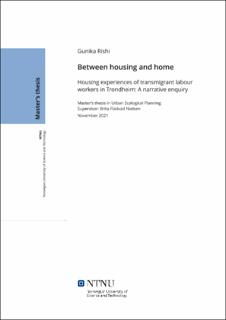| dc.description.abstract | Since the enlargement of the EU in 2004, the free movement of workers has changed the scale and nature of migration patterns throughout Europe. The need to seek better wage and livelihood prospects are the primary reasons that lead workers to live a life in transit. In many economies, including emerging economies, ageing populations, and declining labour forces are also contributing to the growing mobility of workers. Thus, foreign migrant workers are recruited in large numbers from the Central and East European countries in various secondary and manual jobs. Temporary work contracts, geographic proximity and cheap travel options has allowed the workers to sustain a transitory life between their home country and host country.
This qualitative research study is dedicated to understanding the housing experiences of migrant workers in the construction industry, in Trondheim. The scope of the study focuses on skilled workers from Central and Eastern European countries that replace the traditional one-way movement with a continuous back and forth between the home and Trondheim, a phenomenon is also known as transnational migration. The study would also assess the role of stakeholders in shaping the housing experiences of work migrants. The data was generated primarily through observations, focus group, and qualitative interviews with 16 respondents including both workers, and stakeholders. Narrative enquiry approach was adopted to access the daily lives of the participants through detailed conversations, and storytelling. The analysis was based on the individual narratives that emerged through a transitional perspective.
Findings indicate that housing of labour migrants in Trondheim, is perceived by the worker as a temporary shelter that can be easily compromised in order to make investments in their home country, while Trondheim remains a place of work. The perceptions of social exclusion along with the lack of ‘feeling at home’ contributes to a disconnectedness between the worker and the local society. Thus, underpinning the contractual relation the workers have with Trondheim. These findings are supplemented by a preliminary stakeholder map, identifying potential stakeholders who have the knowledge, interest and resources to catalyse a sustained engagement towards a more inclusive and holistic approach to housing. It has been anticipated that Norway’s dependence of foreign labour is only going to increase therefore, the thesis aims to highlight the need to view housing not only as a physical structure but instead to be understood as a complex concept that is a sum of non-physical experiences of the labour migrants. This would ensure that housing experiences of the labour migrants in Trondheim better mirrors the qualities of the Norwegian social welfare state. | en_US |
